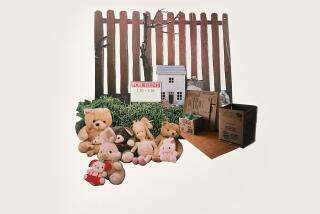Running Home to the Place of Her Dreams : UNDER THE TUSCAN SUN: At Home In Italy by Frances Mayes; Chronicle $22.95, 280 pages
- Share via
“I’m sorry to bother you,” a woman writes to Frances Mayes after reading an article Mayes has written about buying her house in Tuscany, “but I don’t have anyone to discuss this with. I want to do something but I don’t know exactly what.” She is referring to a house 3,000 miles away off the Washington state coast that she wants to buy. Mayes envisions a clapboard cottage, a “blue bicycle leaning against a pine tree, morning glories climbing up the porch railing.” She encourages the woman to buy the house.
This perfect vision is a gift Mayes seems to have. It isn’t just a question of good taste, of style. She seems to be a channeler for the spirit of houses. Restoration, particularly of this house she has chosen in Tuscany, has more in common with archeology, uncovering the spiritual essence of the place. “Every time I dig in the garden,” she writes, “I’m reminded of how many have gone before me on the land. I have a big collection of fragments of dishes, dozens of patterns . . . along with jawbones of a boar and a hedgehog.”
What also sets this book apart from many of its expatriate compatriots, books about running away to live in the place of one’s dreams, is that Mayes is not really running away from anything unbearable, she’s running to something delightful, to a place she has found that feels utterly natural and comfortable to her. This eliminates the often desperate, cloying tone these books can have.
“Once in a place,” she writes, “that journey to the far interior of the psyche begins or it doesn’t. Something must make it yours, that ineffable something no book can capture. It can be so simple, like the light I saw on the faces of the three women walking with their arms linked when the late afternoon sun slanted into the Rugapiana.”
And still, Mayes values her life in America, where she teaches and writes poetry. “I know,” she writes, speaking of her life in Italy, “the appeal to me is partly the balance it restores to my life in America. . . . Spending time here lets me escape the craziness and violence and downright surreal aspects of America, and my own over-scheduled life.”
“After a week or so,” she writes elsewhere, “I have the energy of a 12-year-old.”
And she needs it, for the restoration she has undertaken involves an astonishing amount of back-breaking labor. This is not the Peter Mayle-style restoration job, where the hardest part is making fun of the indigenous laborers. This is two people doing a lot of the stripping, sanding, digging, painting and finishing themselves. With no Home Depot in sight.
When they are not working on the house, Mayes and her companion and sometimes visiting friends and family are eating the fundamental ingredients of Italian cooking, the kind of meals that make you weep with the desire to be there: the prosciutto, the tomatoes, the bruschetta, the olives, the olive oil, the hazelnut cakes.
Some of us are more moved by houses we’ve lived in (this life or previous ones) than others. Some of us dream about rooms more than people.
She writes of a house she rented in Vicchio: “It was a huge house with a caretaker in a side wing. One day I opened what I’d assumed was a closet in an unused bedroom and found a long stone corridor with empty rooms on either side. White doves flew in and out. . . . In many waking moments since, I’ve opened the door to the stony light of that hallway, oblong panels of sunlight on the floor, caught a glimpse and flutter of white wings.”
I do not doubt that centuries from now, whoever lives in Bramasole will one day, digging in the garden, uncover bits of pottery once used at Mayes’ table. She has, by the sweat of her brow and the strength of her vision, become a layer in the history of the place.
More to Read
Sign up for our Book Club newsletter
Get the latest news, events and more from the Los Angeles Times Book Club, and help us get L.A. reading and talking.
You may occasionally receive promotional content from the Los Angeles Times.






